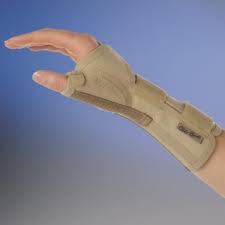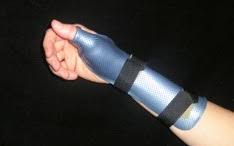The journey through pregnancy and post partum is individual and varied, however, there is no denying that there are significant demands on the body during this time. The wrists are just one part of the body that can be affected through repetitive lifting, positioning your baby to breast feed, calming, holding and changing your newborn.
Many new mothers experience wrist pain during this time which can progress to a condition known as DeQuervain’s tenosynovitis.
De Quervain’s tenosynovitis is one of the most common types of tendinopathies that we see in the world of hand therapy and while it can affect anyone of any age, it is commonly seen in new mothers (or fathers) resulting from lifting and holding a baby frequently.
This condition involves the tendons that ran along the thumb side of the wrist and into the thumb. These tendons are called abductor pollicis longus (APL) and extensor pollicis brevis (EPB).
Tenosynovitis and tendinopathies are caused by a thickening or inflammation of the tendons and the sheath or tunnel they travel through. Symptoms can vary a great deal but this is a condition that can be debilitating and very painful, adding to an already sometimes challenging time.
Symptoms include pain in the area of the wrist below the thumb as seen below.

Like many conditions, once you first notice that you are getting pain, the earlier you seek assessment and treatment, the better.
At Geelong Hand Therapy we can assess your symptoms and guide you through a treatment plan appropriate to you.
Conservative management of DeQuervain’s can be very effective with the following interventions.
Education/activity modification
You will be provided with education regarding techniques of modifying the ways and positions in which you are using your wrists in the context of caring for your baby. This could include changing the way you pick up your baby or trying ways to modify your breast feeding position.
Splinting
You will most likely be fitted with a splint that immobilises your wrist and thumb for a period of rest in order to reduce inflammation. This is in conjunction with compression and icing at home and could be for up to 4-6 weeks depending on your symptoms.


Exercise program
Once your symptoms have started to improve you will be guided through a gentle exercise program designed to gradually re strengthen your wrists.
Cortisone injection
If your symptoms persist despite a period of splinting and rest we can then refer you to your GP for consideration of a cortisone injection into the wrist which, for some, can be an effective way to reduce pain and swelling. This would be then followed by a period of strengthening and graded return to normal functional use of the hand and wrist.
Surgery
There is a surgical option for DeQuervain’s tenosynovitis if your symptoms are severe and persistent or recurrent despite trying the above interventions. This is a process that can be discussed further with your GP should it be relevant to you.
